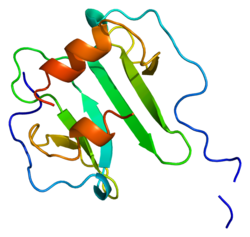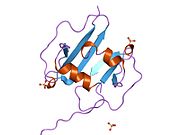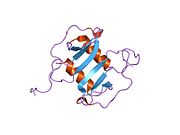The stromal cell-derived factor 1 (SDF-1), also known as C-X-C motif chemokine 12 (CXCL12), is a chemokine protein that in humans is encoded by the CXCL12 gene on chromosome 10. It is ubiquitously expressed in many tissues and cell types. Stromal cell-derived factors 1-alpha and 1-beta are small cytokines that belong to the chemokine family, members of which activate leukocytes and are often induced by proinflammatory stimuli such as lipopolysaccharide, TNF, or IL1. The chemokines are characterized by the presence of 4 conserved cysteines that form 2 disulfide bonds. They can be classified into 2 subfamilies. In the CC subfamily, the cysteine residues are adjacent to each other. In the CXC subfamily, they are separated by an intervening amino acid. The SDF1 proteins belong to the latter group. CXCL12 signaling has been observed in several cancers. The CXCL12 gene also contains one of 27 SNPs associated with increased risk of coronary artery disease.
Structure
Gene
The CXCL12 gene resides on chromosome 10 at the band 10q11.21 and contains 4 exons.. This gene produces 7 isoforms through alternative splicing.
Protein
This protein belongs to the intercrine alpha (chemokine CXC) family. SDF-1 is produced in two forms, SDF-1α/CXCL12a and SDF-1β/CXCL12b, by alternate splicing of the same gene. Chemokines are characterized by the presence of four conserved cysteines, which form two disulfide bonds. The CXCL12 proteins belong to the group of CXC chemokines, whose initial pair of cysteines are separated by one intervening amino acid. In addition, the first 8 residues of the CXCL12 N-terminal serve as a receptor binding site, though only Lys-1 and Pro-2 directly participated in activating the receptor. Meanwhile, the RFFESH motif (residues 12-17) in the loop region function as a docking site for CXCL12 receptor binding.
Function
CXCL12 is expressed in many tissues in mice including brain, thymus, heart, lung, liver, kidney, spleen, platelets and bone marrow. CXCL12 is strongly chemotactic for lymphocytes. During embryogenesis, it directs the migration of hematopoietic cells from fetal liver to bone marrow and the formation of large blood vessels. It has also been shown that CXCL12 signalling regulates the expression of CD20 on B cells. CXCL12 is also chemotactic for mesenchymal stem cells and is expressed in the area of inflammatory bone destruction, where it mediates their suppressive effect on osteoclastogenesis.
In adulthood, CXCL12 plays an important role in angiogenesis by recruiting endothelial progenitor cells (EPCs) from the bone marrow through a CXCR4 dependent mechanism.
CXCR4, previously called LESTR or fusin, is the receptor for CXCL12. This CXCL12-CXCR4 interaction used to be considered exclusive (unlike for other chemokines and their receptors), but recently, it was suggested that CXCL12 may also bind the CXCR7 receptor (now called ACKR3). By blocking CXCR4, a major coreceptor for HIV-1 entry, CXCL12 acts as an endogenous inhibitor of CXCR4-tropic HIV-1 strains.
CNS
During embryonic development, CXCL12 plays a role in cerebellar formation through the migration of neurons. Within the CNS, CXCL12 contributes to cell proliferation, neurogenesis (nervous tissue development and growth), as well as neuroinflammation. Neural progenitor cells (NPCs) are stem cells that differentiate into glial and neuronal cells. CXCL12 promotes their migration to lesion sites within the brain, specifically over extensive ranges. Once at the site of damage, NPCs may begin stem cell based tissue repair to the lesion. The CXCL12/CXCR4 axis provides guidance cues for axons and neurites hence promoting neurite outgrowth (neurons forming projections) and neurogenesis. Like other chemokines, CXCL12 is involved with cell migration that contributes to inflammation. In regards to the CNS, CXCL12 plays a role in neuroinflammation by attracting leukocytes across the blood brain barrier. however, excessive production and accumulation of CXCL12 can become toxic and the inflammation produced may result in serious consequences.
Clinical significance
In humans, CXCL12 has been implicated in a wide variety of biomedical conditions involving several organ systems. Furthermore, CXCL12 signaling in conjunction with CXCR7 signaling has been implicated in the progression of pancreatic cancer. In the urinary tract system, methylation of the CXCL12 promoter and expression of PD-L1 may be powerful prognostic biomarkers for biochemical recurrence in prostate carcinoma patients after radical prostatectomy, and further studies are ongoing to confirm if CXCL12 methylation may aid in active surveillance strategies. In the field of oncology, melanoma associated fibroblasts are stimulated by stimulation of the A2B adenosine receptor followed by stimulation of fibroblast growth factor and increased expression of CXCL12.
Clinical marker
A multi-locus genetic risk score study based on a combination of 27 loci, including the CXCL12 gene, identified individuals at increased risk for both incident and recurrent coronary artery disease events, as well as an enhanced clinical benefit from statin therapy. The study was based on a community cohort study (the Malmo Diet and Cancer study) and four additional randomized controlled trials of primary prevention cohorts (JUPITER and ASCOT) and secondary prevention cohorts (CARE and PROVE IT-TIMI 22).
Multiple Sclerosis
A neurological condition that results from a faulty interaction between the immune and nervous systems in multiple sclerosis. MS is characterized by demyelination of nerves due to the body's immune system attacking the CNS. Elevated levels of CXCL12 are observed in the cerebral spinal fluid of patients with MS. CXCL12 crosses the blood–brain barrier and causes neuroinflammation that contributes to axonal damage and therefore the progression of multiple sclerosis.
Alzheimer's disease
Though CXCL12 may be detrimental for those with MS, recent research is suggesting that this chemokine may be beneficial in decreasing the progression of patients with Alzheimer's. Alzheimer's is another neurological condition and the most common form of dementia where cognition significantly declines. One main characteristic of Alzheimer's is the accumulation of a brain plaque known as beta-amyloid. There are neuroprotective aspects of CXCL12 in mice with these plaques/Alzheimer's. PAK is a protein associated with maintaining dendritic spines, which are essential at synapses in receiving information from axons. Mislocalization of PAK occurs in patients with Alzheimer's, however pretreatment of neurons in mice with CXCL12 showed a suppression of that mislocalization. Additionally, this pretreatment with CXCL decreased the prevalence of apoptosis and oxidative damage normally caused by the presence of the beta-amyloid plaque.
As a drug target
Chemokines and chemokine receptors, of which CXCR stands out, regulate multiple processes such as morphogenesis, angiogenesis, and immune responses and are considered potential targets for drug development. It is indicated by clinical samples that a high expression level of CXCR4 in idiopathic pulmonary fibrosis lungs. Experimental evidence further indicate that CXCR4/CXCR12 is associated with the pathogenesis of lung fibrosis. In the gastrointestinal tract system, the CXCL12-CXCR4 axis is under investigation as an anti-fibrotic therapy in the treatment for chronic pancreatitis. For instance, blocking CXCR4, the receptor for CXCL12, with Plerixafor (AMD-3100) increased the effectiveness of combretastatin in a mouse model of breast cancer, presumably by preventing macrophages from being recruited to tumours. AMD-3100 is also widely used in combination with G-CSF for mobilizing hematopoietic stem cells into the blood stream, allowing collection for bone marrow transplant.
References
- ^ GRCh38: Ensembl release 89: ENSG00000107562 – Ensembl, May 2017
- ^ GRCm38: Ensembl release 89: ENSMUSG00000061353 – Ensembl, May 2017
- "Human PubMed Reference:". National Center for Biotechnology Information, U.S. National Library of Medicine.
- "Mouse PubMed Reference:". National Center for Biotechnology Information, U.S. National Library of Medicine.
- ^ "Entrez Gene: CXCL12 chemokine (C-X-C motif) ligand 12 (stromal cell-derived factor 1)".
- "BioGPS - your Gene Portal System". biogps.org. Retrieved 11 October 2016.
- ^ Guo JC, Li J, Zhou L, Yang JY, Zhang ZG, Liang ZY, Zhou WX, You L, Zhang TP, Zhao YP (August 2016). "CXCL12-CXCR7 axis contributes to the invasive phenotype of pancreatic cancer". Oncotarget. 7 (38): 62006–62018. doi:10.18632/oncotarget.11330. PMC 5308707. PMID 27542220.
- ^ Sorrentino C, Miele L, Porta A, Pinto A, Morello S (August 2016). "Activation of the A2B adenosine receptor in B16 melanomas induces CXCL12 expression in FAP-positive tumor stromal cells, enhancing tumor progression". Oncotarget. 7 (39): 64274–64288. doi:10.18632/oncotarget.11729. PMC 5325441. PMID 27590504.
- ^ Mega JL, Stitziel NO, Smith JG, Chasman DI, Caulfield MJ, Devlin JJ, Nordio F, Hyde CL, Cannon CP, Sacks FM, Poulter NR, Sever PS, Ridker PM, Braunwald E, Melander O, Kathiresan S, Sabatine MS (June 2015). "Genetic risk, coronary heart disease events, and the clinical benefit of statin therapy: an analysis of primary and secondary prevention trials". Lancet. 385 (9984): 2264–71. doi:10.1016/S0140-6736(14)61730-X. PMC 4608367. PMID 25748612.
- "CXCL12 gene information - The Human Protein Atlas". www.proteinatlas.org. Retrieved 20 March 2024.
- ^ "CXCL12 - Stromal cell-derived factor 1 precursor - Homo sapiens (Human) - CXCL12 gene & protein". UniProt.
- De La Luz Sierra M, Yang F, Narazaki M, Salvucci O, Davis D, Yarchoan R, Zhang HH, Fales H, Tosato G (April 2004). "Differential processing of stromal-derived factor-1alpha and stromal-derived factor-1beta explains functional diversity". Blood. 103 (7): 2452–9. doi:10.1182/blood-2003-08-2857. PMID 14525775.
- Crump MP, Gong JH, Loetscher P, Rajarathnam K, Amara A, Arenzana-Seisdedos F, Virelizier JL, Baggiolini M, Sykes BD, Clark-Lewis I (December 1997). "Solution structure and basis for functional activity of stromal cell-derived factor-1; dissociation of CXCR4 activation from binding and inhibition of HIV-1". The EMBO Journal. 16 (23): 6996–7007. doi:10.1093/emboj/16.23.6996. PMC 1170303. PMID 9384579.
- Schrader AJ, Lechner O, Templin M, Dittmar KE, Machtens S, Mengel M, Probst-Kepper M, Franzke A, Wollensak T, Gatzlaff P, Atzpodien J, Buer J, Lauber J (April 2002). "CXCR4/CXCL12 expression and signalling in kidney cancer". British Journal of Cancer. 86 (8): 1250–6. doi:10.1038/sj.bjc.6600221. PMC 2375348. PMID 11953881.
- Custo S, Baron B, Felice A, Seria E (5 July 2022). "A comparative profile of total protein and six angiogenically-active growth factors in three platelet products". GMS Interdisciplinary Plastic and Reconstructive Surgery DGPW. 11 (Doc06): Doc06. doi:10.3205/iprs000167. PMC 9284722. PMID 35909816.
- ^ Bleul CC, Fuhlbrigge RC, Casasnovas JM, Aiuti A, Springer TA (September 1996). "A highly efficacious lymphocyte chemoattractant, stromal cell-derived factor 1 (SDF-1)". The Journal of Experimental Medicine. 184 (3): 1101–9. doi:10.1084/jem.184.3.1101. PMC 2192798. PMID 9064327.
- Ara T, Nakamura Y, Egawa T, Sugiyama T, Abe K, Kishimoto T, Matsui Y, Nagasawa T (April 2003). "Impaired colonization of the gonads by primordial germ cells in mice lacking a chemokine, stromal cell-derived factor-1 (SDF-1)". Proceedings of the National Academy of Sciences of the United States of America. 100 (9): 5319–23. Bibcode:2003PNAS..100.5319A. doi:10.1073/pnas.0730719100. PMC 154343. PMID 12684531.
- Askari AT, Unzek S, Popovic ZB, Goldman CK, Forudi F, Kiedrowski M, Rovner A, Ellis SG, Thomas JD, DiCorleto PE, Topol EJ, Penn MS (August 2003). "Effect of stromal-cell-derived factor 1 on stem-cell homing and tissue regeneration in ischaemic cardiomyopathy". Lancet. 362 (9385): 697–703. doi:10.1016/S0140-6736(03)14232-8. PMID 12957092. S2CID 24354002.
- Ma Q, Jones D, Borghesani PR, Segal RA, Nagasawa T, Kishimoto T, Bronson RT, Springer TA (August 1998). "Impaired B-lymphopoiesis, myelopoiesis, and derailed cerebellar neuron migration in CXCR4- and SDF-1-deficient mice". Proceedings of the National Academy of Sciences of the United States of America. 95 (16): 9448–53. Bibcode:1998PNAS...95.9448M. doi:10.1073/pnas.95.16.9448. PMC 21358. PMID 9689100.
- Takano T, Li YJ, Kukita A, Yamaza T, Ayukawa Y, Moriyama K, Uehara N, Nomiyama H, Koyano K, Kukita T (2014). "Mesenchymal stem cells markedly suppress inflammatory bone destruction in rats with adjuvant-induced arthritis". Laboratory Investigation. 94 (3): 286–96. doi:10.1038/labinvest.2013.152. PMID 24395111.
- Zheng H, Fu G, Dai T, Huang H (2007). "Migration of endothelial progenitor cells mediated by stromal cell-derived factor-1alpha/CXCR4 via PI3K/Akt/eNOS signal transduction pathway". Journal of Cardiovascular Pharmacology. 50 (3): 274–80. doi:10.1097/FJC.0b013e318093ec8f. PMID 17878755. S2CID 13616442.
- Balabanian K, Lagane B, Infantino S, Chow KY, Harriague J, Moepps B, Arenzana-Seisdedos F, Thelen M, Bachelerie F (2005). "The chemokine SDF-1/CXCL12 binds to and signals through the orphan receptor RDC1 in T lymphocytes". The Journal of Biological Chemistry. 280 (42): 35760–6. doi:10.1074/jbc.M508234200. PMID 16107333.
- Burns JM, Summers BC, Wang Y, Melikian A, Berahovich R, Miao Z, Penfold ME, Sunshine MJ, Littman DR, Kuo CJ, Wei K, McMaster BE, Wright K, Howard MC, Schall TJ (2006). "A novel chemokine receptor for SDF-1 and I-TAC involved in cell survival, cell adhesion, and tumor development". The Journal of Experimental Medicine. 203 (9): 2201–13. doi:10.1084/jem.20052144. PMC 2118398. PMID 16940167.
- Cruz-Orengo L, Holman DW, Dorsey D, Zhou L, Zhang P, Wright M, McCandless EE, Patel JR, Luker GD, Littman DR, Russell JH, Klein RS (2011). "CXCR7 influences leukocyte entry into the CNS parenchyma by controlling abluminal CXCL12 abundance during autoimmunity". The Journal of Experimental Medicine. 208 (2): 327–39. doi:10.1084/jem.20102010. PMC 3039853. PMID 21300915.
- Oberlin E, Amara A, Bachelerie F, Bessia C, Virelizier JL, Arenzana-Seisdedos F, Schwartz O, Heard JM, Clark-Lewis I, Legler DF, Loetscher M, Baggiolini M, Moser B (1996). "The CXC chemokine SDF-1 is the ligand for LESTR/fusin and prevents infection by T-cell-line-adapted HIV-1" (PDF). Nature. 382 (6594): 833–5. Bibcode:1996Natur.382..833O. doi:10.1038/382833a0. PMID 8752281. S2CID 4233446.
- Bajetto A, Bonavia R, Barbero S, Florio T, Schettini G (July 2001). "Chemokines and their receptors in the central nervous system". Frontiers in Neuroendocrinology. 22 (3): 147–84. doi:10.1006/frne.2001.0214. PMID 11456467. S2CID 29689159.
- ^ Li M, Hale JS, Rich JN, Ransohoff RM, Lathia JD (October 2012). "Chemokine CXCL12 in neurodegenerative diseases: an SOS signal for stem cell-based repair". Trends in Neurosciences. 35 (10): 619–28. doi:10.1016/j.tins.2012.06.003. PMC 3461091. PMID 22784557.
- Guyon A (March 2014). "CXCL12 chemokine and its receptors as major players in the interactions between immune and nervous systems". Frontiers in Cellular Neuroscience. 8: 65. doi:10.3389/fncel.2014.00065. PMC 3944789. PMID 24639628.
- Guyon A (2014). "CXCL12 chemokine and its receptors as major players in the interactions between immune and nervous systems". Frontiers in Cellular Neuroscience. 8: 65. doi:10.3389/fncel.2014.00065. PMC 3944789. PMID 24639628.
- Pozzobon T, Goldoni G, Viola A, Molon B (September 2016). "CXCR4 signaling in health and disease". Immunology Letters. 177: 6–15. doi:10.1016/j.imlet.2016.06.006. hdl:11577/3222781. PMID 27363619.
- Goltz D, Holmes EE, Gevensleben H, Sailer V, Dietrich J, Jung M, Röhler M, Meller S, Ellinger J, Kristiansen G, Dietrich D (July 2016). "CXCL12 promoter methylation and PD-L1 expression as prognostic biomarkers in prostate cancer patients". Oncotarget. 7 (33): 53309–53320. doi:10.18632/oncotarget.10786. PMC 5288188. PMID 27462860.
- Krumbholz M, Theil D, Cepok S, Hemmer B, Kivisäkk P, Ransohoff RM, Hofbauer M, Farina C, Derfuss T, Hartle C, Newcombe J, Hohlfeld R, Meinl E (January 2006). "Chemokines in multiple sclerosis: CXCL12 and CXCL13 up-regulation is differentially linked to CNS immune cell recruitment". Brain: A Journal of Neurology. 129 (Pt 1): 200–11. doi:10.1093/brain/awh680. PMID 16280350.
- ^ Raman D, Milatovic SZ, Milatovic D, Splittgerber R, Fan GH, Richmond A (November 2011). "Chemokines, macrophage inflammatory protein-2 and stromal cell-derived factor-1α, suppress amyloid β-induced neurotoxicity". Toxicology and Applied Pharmacology. 256 (3): 300–13. Bibcode:2011ToxAP.256..300R. doi:10.1016/j.taap.2011.06.006. PMC 3236026. PMID 21704645.
- Li F, Xu X, Geng J, Wan X, Dai H (March 2020). "The autocrine CXCR4/CXCL12 axis contributes to lung fibrosis through modulation of lung fibroblast activity". Experimental and Therapeutic Medicine. 19 (3): 1844–1854. doi:10.3892/etm.2020.8433. PMC 7027131. PMID 32104240.
- Neesse A, Ellenrieder V (September 2016). "NEMO-CXCL12/CXCR4 axis: a novel vantage point for antifibrotic therapies in chronic pancreatitis?". Gut. 66 (2): gutjnl–2016–312874. doi:10.1136/gutjnl-2016-312874. PMID 27590996. S2CID 3493909.
- De Clercq E. (2019) Mozobil(R) (Plerixafor, AMD3100), 10 years after its approval by the US Food and Drug Administration. Antivir Chem Chemother 27:1.
Further reading
- Kucia M, Reca R, Miekus K, Wanzeck J, Wojakowski W, Janowska-Wieczorek A, Ratajczak J, Ratajczak MZ (August 2005). "Trafficking of normal stem cells and metastasis of cancer stem cells involve similar mechanisms: pivotal role of the SDF-1-CXCR4 axis". Stem Cells. 23 (7): 879–94. doi:10.1634/stemcells.2004-0342. PMID 15888687. S2CID 22504846.
- Kryczek I, Wei S, Keller E, Liu R, Zou W (March 2007). "Stroma-derived factor (SDF-1/CXCL12) and human tumor pathogenesis". American Journal of Physiology. Cell Physiology. 292 (3): C987–95. doi:10.1152/ajpcell.00406.2006. PMID 16943240. S2CID 7423893.
- Stellos K, Gawaz M (March 2007). "Platelets and stromal cell-derived factor-1 in progenitor cell recruitment". Seminars in Thrombosis and Hemostasis. 33 (2): 159–64. doi:10.1055/s-2007-969029. PMID 17340464. S2CID 260320898.
- Wang J, Liu X, Lu H, Jiang C, Cui X, Yu L, Fu X, Li Q, Wang J (March 2015). "CXCR4(+)CD45(-) BMMNC subpopulation is superior to unfractionated BMMNCs for protection after ischemic stroke in mice". Brain, Behavior, and Immunity. 45: 98–108. doi:10.1016/j.bbi.2014.12.015. PMC 4342301. PMID 25526817.
- Arya M, Ahmed H, Silhi N, Williamson M, Patel HR (2007). "Clinical importance and therapeutic implications of the pivotal CXCL12-CXCR4 (chemokine ligand-receptor) interaction in cancer cell migration". Tumour Biology. 28 (3): 123–31. doi:10.1159/000102979. PMID 17510563. S2CID 44356923.
| PDB gallery | |
|---|---|
|
| Cell signaling: cytokines | |||||||||||||||||||||||||||||||||||||||||||
|---|---|---|---|---|---|---|---|---|---|---|---|---|---|---|---|---|---|---|---|---|---|---|---|---|---|---|---|---|---|---|---|---|---|---|---|---|---|---|---|---|---|---|---|
| By family |
| ||||||||||||||||||||||||||||||||||||||||||
| By function/ cell | |||||||||||||||||||||||||||||||||||||||||||
| Chemokine receptor modulators | |||||||||||||||||||||||||
|---|---|---|---|---|---|---|---|---|---|---|---|---|---|---|---|---|---|---|---|---|---|---|---|---|---|
| CC |
| ||||||||||||||||||||||||
| CXC |
| ||||||||||||||||||||||||
| C (XC) |
| ||||||||||||||||||||||||
| CX3C |
| ||||||||||||||||||||||||
| Others |
| ||||||||||||||||||||||||
Categories:













